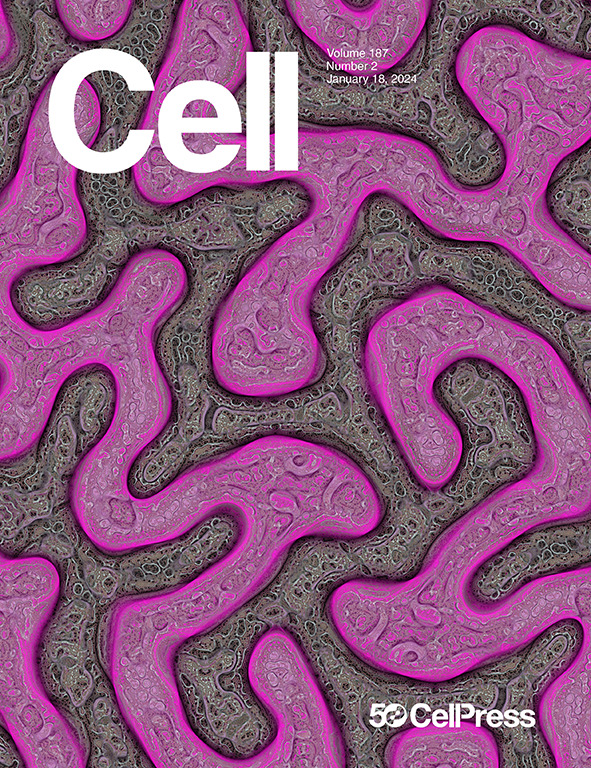核应激体从头组装重排并增强NFIL3以抑制急性炎症反应
IF 42.5
1区 生物学
Q1 BIOCHEMISTRY & MOLECULAR BIOLOGY
引用次数: 0
摘要
以卫星III (SatIII) rna为标志的无膜核应激体(nsb)存在于灵长类动物的应激感知中。我们报道了SatⅢdna、SatⅢrna和30个nSB蛋白在应激后不久组装成组织良好的结构。活化的SatⅢ异染色质位点迅速扩大,导致空间距离减少,邻近基因的表达增强,包括转录抑制因子NFIL3,已知其可抑制促炎细胞因子的产生。NFIL3基因座在nSB区域内的重排增强了NFIL3染色质的可及性,使NFIL3启动子更容易被转录因子热休克转录因子1 (HSF1)和含溴结构域4 (BRD4)所接近,这些转录因子在逆境下也会被nSB招募。人外周血单核细胞(PBMC)来源的巨噬细胞在热休克和病原体相关分子模式处理下表现出升高的SatⅢ和NFIL3表达,后者抑制关键的炎症细胞因子。重要的是,在脓毒症患者中,NFIL3表达与SatⅢ激活呈正相关,这一过程与患者生存呈正相关,突出了nsb在抑制炎症反应中的作用。本文章由计算机程序翻译,如有差异,请以英文原文为准。

De novo assembly of nuclear stress bodies rearranges and enhances NFIL3 to restrain acute inflammatory responses
The membrane-less nuclear stress bodies (nSBs), with satellite III (SatIII) RNAs as the hallmark, are present in primates upon sensing stresses. We report that SatⅢ DNAs, SatⅢ RNAs, and 30 nSB proteins assemble into well-organized structures shortly after stresses. The activated SatⅢ heterochromatin loci rapidly expand, resulting in reduced spatial distance and enhanced expression of adjacent genes, including the transcription suppressor NFIL3, which is known to dampen proinflammatory cytokine production. Rearranging NFIL3 loci within the nSB territory enhances NFIL3 chromatin accessibility and makes NFIL3 promoters more accessible to transcription factors heat shock transcription factor 1 (HSF1) and bromodomain containing 4 (BRD4), which are also recruited to nSBs upon stresses. Human peripheral blood mononuclear cell (PBMC)-derived macrophages under heat shock plus pathogen-associated molecular pattern treatments exhibit increased SatⅢ and NFIL3 expression, the latter of which suppresses key inflammatory cytokines. Importantly, NFIL3 expression positively correlates with SatⅢ activation in septic patients, a process positively correlated to patient survival, highlighting a role of nSBs in restraining inflammatory responses.
求助全文
通过发布文献求助,成功后即可免费获取论文全文。
去求助
来源期刊

Cell
生物-生化与分子生物学
CiteScore
110.00
自引率
0.80%
发文量
396
审稿时长
2 months
期刊介绍:
Cells is an international, peer-reviewed, open access journal that focuses on cell biology, molecular biology, and biophysics. It is affiliated with several societies, including the Spanish Society for Biochemistry and Molecular Biology (SEBBM), Nordic Autophagy Society (NAS), Spanish Society of Hematology and Hemotherapy (SEHH), and Society for Regenerative Medicine (Russian Federation) (RPO).
The journal publishes research findings of significant importance in various areas of experimental biology, such as cell biology, molecular biology, neuroscience, immunology, virology, microbiology, cancer, human genetics, systems biology, signaling, and disease mechanisms and therapeutics. The primary criterion for considering papers is whether the results contribute to significant conceptual advances or raise thought-provoking questions and hypotheses related to interesting and important biological inquiries.
In addition to primary research articles presented in four formats, Cells also features review and opinion articles in its "leading edge" section, discussing recent research advancements and topics of interest to its wide readership.
 求助内容:
求助内容: 应助结果提醒方式:
应助结果提醒方式:


